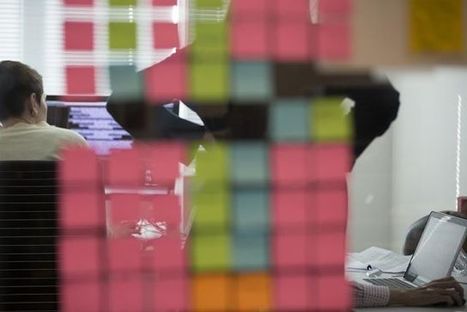Learning by Doing
Education, like life itself, should not be a spectator sport. Merely listening or even reading may create the illusion of learning, but without active engagement, retention of course material, or the ability to apply it, is laughably low. Students who engage in hands-on activities understand concepts more deeply and remember them more accurately.
Project-based, case-based, and team-based learning and problem-solving are activity-based approaches to teaching and learning, allowing students to become creators of knowledge rather than mere recipients of knowledge.
Students might annotate a text or play or work of art, map and analyze data, visually represent change over time, document a neighborhood or community. The web can then make student projects and research publicly accessible.
By learning by doing can take even richer forms. A solver community brings together students and faculty to “crowdsource” innovative solutions to the critical challenges of our time. Tackling a real-world challenge is a proven way to nurture a community of engage, creative learners. One of the broader goals is to transform a class of students into a knowledge network, an ongoing community that can continue to partner and share expertise and insights.
Then there are maker spaces. These are innovation greenhouses, incubators, or accelerators where innovators – whether faculty, students, staff, or others from outside the campus – can work individually or collaborative on projects in a supportive environment.
A new kind of student populates many campuses defined not by demographic characteristics, but by mindset and aspirations. Extraordinarily entrepreneurial, these students, in their spare time, create apps, found start-ups, and devise creative solutions to a host of pressing environmental, health, and technology problems.
Learn more / En savoir plus / Mehr erfahren:
https://gustmees.wordpress.com/2014/10/03/design-the-learning-of-your-learners-students-ideas/
Via Gust MEES



 Your new post is loading...
Your new post is loading...














Learning by Doing
Education, like life itself, should not be a spectator sport. Merely listening or even reading may create the illusion of learning, but without active engagement, retention of course material, or the ability to apply it, is laughably low. Students who engage in hands-on activities understand concepts more deeply and remember them more accurately.
Project-based, case-based, and team-based learning and problem-solving are activity-based approaches to teaching and learning, allowing students to become creators of knowledge rather than mere recipients of knowledge.
Students might annotate a text or play or work of art, map and analyze data, visually represent change over time, document a neighborhood or community. The web can then make student projects and research publicly accessible.
By learning by doing can take even richer forms. A solver community brings together students and faculty to “crowdsource” innovative solutions to the critical challenges of our time. Tackling a real-world challenge is a proven way to nurture a community of engage, creative learners. One of the broader goals is to transform a class of students into a knowledge network, an ongoing community that can continue to partner and share expertise and insights.
Then there are maker spaces. These are innovation greenhouses, incubators, or accelerators where innovators – whether faculty, students, staff, or others from outside the campus – can work individually or collaborative on projects in a supportive environment.
A new kind of student populates many campuses defined not by demographic characteristics, but by mindset and aspirations. Extraordinarily entrepreneurial, these students, in their spare time, create apps, found start-ups, and devise creative solutions to a host of pressing environmental, health, and technology problems.
Learn more / En savoir plus / Mehr erfahren:
https://gustmees.wordpress.com/2015/07/19/learning-path-for-professional-21st-century-learning-by-ict-practice/
https://gustmees.wordpress.com/2014/10/03/design-the-learning-of-your-learners-students-ideas/
Learning by Doing
Education, like life itself, should not be a spectator sport. Merely listening or even reading may create the illusion of learning, but without active engagement, retention of course material, or the ability to apply it, is laughably low. Students who engage in hands-on activities understand concepts more deeply and remember them more accurately.
Project-based, case-based, and team-based learning and problem-solving are activity-based approaches to teaching and learning, allowing students to become creators of knowledge rather than mere recipients of knowledge.
Students might annotate a text or play or work of art, map and analyze data, visually represent change over time, document a neighborhood or community. The web can then make student projects and research publicly accessible.
By learning by doing can take even richer forms. A solver community brings together students and faculty to “crowdsource” innovative solutions to the critical challenges of our time. Tackling a real-world challenge is a proven way to nurture a community of engage, creative learners. One of the broader goals is to transform a class of students into a knowledge network, an ongoing community that can continue to partner and share expertise and insights.
Then there are maker spaces. These are innovation greenhouses, incubators, or accelerators where innovators – whether faculty, students, staff, or others from outside the campus – can work individually or collaborative on projects in a supportive environment.
A new kind of student populates many campuses defined not by demographic characteristics, but by mindset and aspirations. Extraordinarily entrepreneurial, these students, in their spare time, create apps, found start-ups, and devise creative solutions to a host of pressing environmental, health, and technology problems.
Learn more / En savoir plus / Mehr erfahren:
https://gustmees.wordpress.com/2015/07/19/learning-path-for-professional-21st-century-learning-by-ict-practice/
https://gustmees.wordpress.com/2014/10/03/design-the-learning-of-your-learners-students-ideas/
Learning by Doing
Education, like life itself, should not be a spectator sport. Merely listening or even reading may create the illusion of learning, but without active engagement, retention of course material, or the ability to apply it, is laughably low. Students who engage in hands-on activities understand concepts more deeply and remember them more accurately.
Project-based, case-based, and team-based learning and problem-solving are activity-based approaches to teaching and learning, allowing students to become creators of knowledge rather than mere recipients of knowledge.
Students might annotate a text or play or work of art, map and analyze data, visually represent change over time, document a neighborhood or community. The web can then make student projects and research publicly accessible.
By learning by doing can take even richer forms. A solver community brings together students and faculty to “crowdsource” innovative solutions to the critical challenges of our time. Tackling a real-world challenge is a proven way to nurture a community of engage, creative learners. One of the broader goals is to transform a class of students into a knowledge network, an ongoing community that can continue to partner and share expertise and insights.
Then there are maker spaces. These are innovation greenhouses, incubators, or accelerators where innovators – whether faculty, students, staff, or others from outside the campus – can work individually or collaborative on projects in a supportive environment.
A new kind of student populates many campuses defined not by demographic characteristics, but by mindset and aspirations. Extraordinarily entrepreneurial, these students, in their spare time, create apps, found start-ups, and devise creative solutions to a host of pressing environmental, health, and technology problems.
Learn more / En savoir plus / Mehr erfahren:
https://gustmees.wordpress.com/2015/07/19/learning-path-for-professional-21st-century-learning-by-ict-practice/
https://gustmees.wordpress.com/2014/10/03/design-the-learning-of-your-learners-students-ideas/